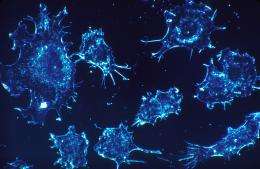Strategy discovered to activate genes that suppress tumors and inhibit cancer

(Medical Xpress) -- A team of scientists has developed a promising new strategy for "reactivating" genes that cause cancer tumors to shrink and die. The researchers hope that their discovery will aid in the development of an innovative anti-cancer drug that effectively targets unhealthy, cancerous tissue without damaging healthy, non-cancerous tissue and vital organs. The research will be published in the Journal of Biological Chemistry.
The team, led by Yanming Wang, a Penn State University associate professor of biochemistry and molecular biology, and Gong Chen, a Penn State assistant professor of chemistry, developed the new strategy after years of earlier research on a gene called PAD4 (peptidylarginine deiminase 4), which produces the PAD4 enzyme. Previous research by Wang and other scientists revealed that the PAD4 enzyme plays an important role in protecting the body from infection. The scientists compared normal mice with a functioning PAD4 gene to other mice that had a defective a PAD4 gene. When infected with bacteria, cells from the normal mice attacked and killed about 30 percent of the harmful bacteria, while cells from the defective mice battled a mere 10 percent. The researchers discovered that cells with a functioning PAD4 enzyme are able to build around themselves a protective, bacteria-killing web that Wang and his colleagues dubbed a NET (neutrophil extracellular trap). This NET is especially effective at fighting off flesh-eating bacteria.
Now, in their new study, Wang and his collaborators have focused on the less-desirable effects of the same PAD4 gene. While PAD4 is clearly a critical part of the body's defense strategy, the gene's over-expression may be linked to autoimmune diseases such as rheumatoid arthritis and multiple sclerosis. One situation in which the PAD4 enzyme is markedly increased is in patients with certain cancers, such as breast, lung, and bone cancers. "We know that the PAD4 gene acts to silence tumor-suppressor genes," said Wang. "So we theorized that by inhibiting the enzyme that this gene produces, the 'good guys' -- the tumor-suppressor genes -- would do a better job at destroying cancerous tissue and allowing the body to heal."
To test their theory, Wang and his colleagues treated mice that had cancerous tumors with a molecule to inhibit the PAD4 enzyme. They found that, especially when combined with additional enzyme inhibitors, the treatment worked as effectively as the most-commonly-used chemotherapy drug, doxorubicin, which shrinks tumors by about 70 percent.
Most striking, however, was that the PAD4 enzyme-inhibition strategy caused significantly less damage to healthy tissues. "Current chemotherapy drugs such as doxorubicin don't attack just tumors; unfortunately, they also attack healthy areas of the body," Wang explained. "That's why chemotherapy patients experience such terrible side effects such as weight loss, nausea, and hair loss. Because the PAD4 treatment appears to be less toxic, it could be an excellent alternative to current chemotherapy treatments."
Wang also explained that the PAD4 gene's dual personality -- on the one hand a helpful defense against bacteria, while on the other, a harmful silencer of cancer-suppressor genes -- can be understood from the perspectives of evolution and longer life spans. "Our ancestors didn't have antibiotics, so a bacterial infection could easily result in death, especially in young children," Wang explained. "So, back then, an overactive PAD4 gene was advantageous because the NET bacteria-trapping mechanism was the body's major defense against infection." Wang also explained that on the other hand, because people today have access to antibiotics, we live much longer than our ancestors did. "PAD4's bad effects -- cancer and autoimmune diseases -- tend to be illnesses that appear later in life," Wang said. "So nowadays, an overactive PAD4 gene, while still protective against bacteria, can be detrimental later in life."
This research was funded by the National Cancer Institute of the National Institutes of Health and a Penn State Clinical and Translational Science Institute Pilot Grant Award to Wang and Chen. In addition to Wang and Chen, other researchers who contributed to this project include Yuji Wang, Pingxin Li, Shu Wang, Jing Hu, Megan Fisher, Kira Oshaben, Jianhui Wu, Na Zhao, Ying Gu of Penn State's Center for Eukaryotic Gene Regulation and the Department of Biochemistry and Molecular Biology.
Journal information: Journal of Biological Chemistry
Provided by Pennsylvania State University
















